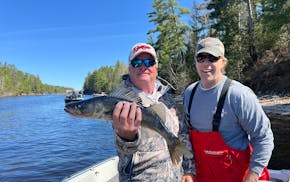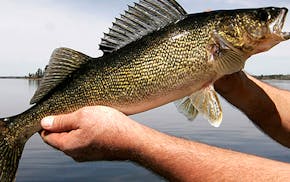More than 10 inches of rain falling in about two days can wreak a lot of damage. To people, yes, and homes and farms and crops and also county roads, some of which in southwest Minnesota remain impassable.
Largely unseen is the threat such deluges pose to wildlife. Some ground-burrowing animals such as woodchucks and gophers — neither of which gains much sympathy from Minnesotans — and also foxes and coyotes can have their homes washed out in heavy cloudbursts. Newly born deer fawns, in some cases, are also at risk.
But it's ground-nesting birds that often fall victim in the greatest numbers to thunderstorms like those that inundated vast swaths of southern Minnesota in June. Bobolinks are among these, as are meadowlarks and dickcissels.
The bird that gains the most attention, however, during and after spring and early summer washouts is the pheasant, largely because ringnecks have the state's largest prairie-bird fan base. Minnesota pheasant hunters number about 100,000.
Some of these wing shooters might go afield only two or three times a season. But many more eat, drink and think about these florid fowl year-round and train their retrievers, pointers and setters to do the same. When heavy rains fall, particularly in mid-June, during the peak hatching season of Phasianus colchicus, the collective mind's eye of this bunch envisions bleakly that pheasant nests and eggs are washed away en masse. With them go chances for limits of roosters rising before hunters' gun in October.
"I drove more than 1,000 miles in southwest Minnesota after the rains stopped," said Scott Rall, of Worthington, who earlier this year was named Pheasants Forever's National Volunteer of the Year. "I saw a lot of adult pheasants, more than 150. But I only saw three broods, and that was in the last few days."
Department of Natural Resources staff across the state's pheasant range — roughly the southern third of Minnesota — also have spotted pheasant broods, large and small, both before and after the June rains.
"We've also seen some lone hens," said DNR wildlife research supervisor Nicole Davros, who is stationed in Madelia, Minn. "That could indicate they are on a nest and just going out to forage before returning to the nest."
Minnesota pheasants, along with those in North and South Dakota, were poised to increase their numbers significantly this spring and early summer. The mild winter ensured cold-weather losses of these birds were relatively minimal and also indicated hens would enter the nesting season with significant fat reserves. A hen's good health is especially important during nesting and brood rearing.
Evidence of how well Midwest pheasants fared last winter showed up in North Dakota's recently completed spring crowing counts. The surveys record the number of "crowing" roosters that can be heard at predetermined locations.
The North Dakota counts were up 37% this year from a year ago, according to the state's Game and Fish Department.
Davros said hens that lost nests to the recent rains will re-nest once, and sometimes even multiple times, in attempts to produce chicks. But the later in summer a brood is produced, the less likely the young birds will be hardy enough to survive the coming winter.
Also, with each re-nesting, hens typically produce fewer eggs. And hens that lose nests deep into their approximately 23-day incubation period typically take longer to re-nest than hens that lose nests early in incubation, Davros added.
"Another consideration," she said, "is that, with the early spring, the nesting season might have started earlier this year than normal. But this spring, unfortunately, like June, was fairly wet, which wouldn't have helped nesting success. We just don't know yet because young chicks can be difficult to see until they're older."
The challenge for chicks that hatched before the heavy June rains is that for the first 10 days to two weeks of their lives, the young birds can't thermoregulate, meaning they're dependent on their mothers to provide warmth and shelter, usually by spreading their wings, with chicks huddled below.
Also, pheasant chicks can't fly for approximately three weeks, so the only way they could escape flood waters would be to walk, which would be problematic, given the extensive field flooding that occurred in June across southern Minnesota.
Heavy rains also fell last month farther north in the state's pheasant range, with 5.6 inches recorded, for example, in Morris June 21-22. Large hail and strong winds accompanied that storm.
Parts of South Dakota, which is regarded as ground zero for pheasant populations, also got hit hard. Mitchell, S.D., typically receives 2.84 inches of rain for all of June but was drenched with 7.89 inches in two days last month. The small town of Canton, about 24 miles south of Sioux Falls, recorded more than 18 inches from the same storm.
Better conditions could be found farther north, near Aberdeen — also a South Dakota pheasant hotspot — where only 2.6 inches of rain fell in June.
The good news, said Rall, is that thanks to efforts by local Pheasants Forever chapters, as well as state and federal conservation initiatives, more productive upland habitat is on the ground in the state's pheasant range now than has been the case in recent decades.
Davros agreed, saying, "We're still seeing many weedy, unsprayed crop fields this spring. These could provide good brood-rearing cover for hens and chicks, with lots of insects, and maybe even some low-quality nesting cover. We still have some time left."

Anderson: Crane Lake gives up its walleyes — and its memories
Anderson: Minnesota's million anglers should be convinced that Boundary Waters is worth protecting

You asked, and we answered our audience's questions about Minnesota's fishing opener.


